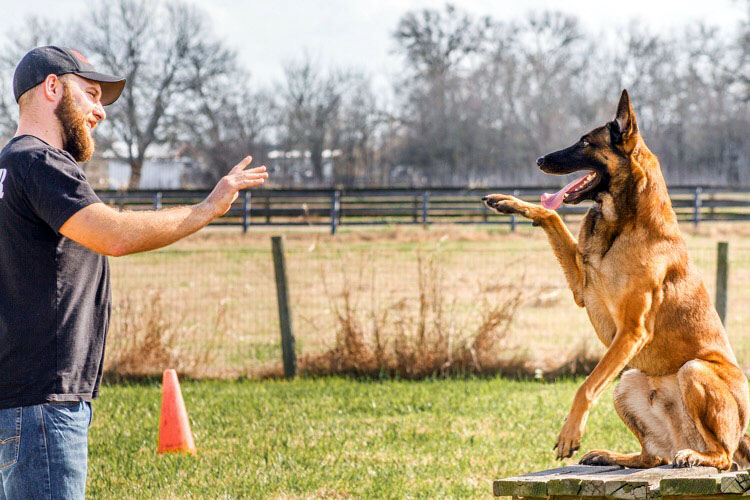Dog training solutions for behavioral improvement.
Dog training solutions for behavioral improvement.
Blog Article
Leading Pet Dog Training Tips for a Well-Behaved Companion
Training your dog to be a well-behaved companion needs a nuanced understanding of canine behavior and the execution of reliable techniques. The journey to a genteel family pet entails even more than just these fundamentals; it requires a much deeper exploration of techniques that can change your training technique.
Comprehending Canine Habits
Understanding canine habits is vital for reliable pet training and fostering a harmonious partnership in between dogs and their owners. Pet dogs are complicated animals, showing a vast array of habits affected by genes, environment, and socialization. Acknowledging the underlying inspirations for a pet dog's activities-- such as anxiety, excitement, or territorial instincts-- can considerably improve training efficiency.
Observing body movement is a vital element of comprehending canine habits. Tail setting, ear alignment, and pose can give valuable insights right into a dog's mood. For example, a wagging tail does not constantly show happiness; it can also signify agitation or anxiety. Social communications with various other canines and people play a critical duty in forming actions. Pet dogs that experience favorable socializing are usually more adaptable and courteous.

Crucial Training Commands
Grasping necessary training commands is crucial for establishing effective interaction in between pets and their owners. These commands serve as the structure for a mannerly pet and can considerably improve the general connection in between pet dog and owner.
Key commands include "Sit," "Remain," "Come," "Down," and "Heel." The command "Sit" is commonly the very first educated, as it encourages calmness and focus. "Remain" strengthens a pet's capacity to continue to be in one setting, advertising self-discipline. "Come" is crucial for security, making sure that your pet dog go back to you when called. "Down" instructs your canine to lie down, which can help in taking care of fired up actions. Dog training near me. Finally, "Heel" shows your pet dog to walk alongside you, fostering far better chain manners.
Exercising these commands in different environments assists dogs generalise their training and respond suitably, regardless of distractions. By spending time in teaching these necessary commands, owners can grow a harmonious and respectful partnership with their canine buddies, boosting both safety and satisfaction in everyday interactions.
Favorable Reinforcement Methods
Favorable reinforcement methods are crucial methods in pet training that concentrate on rewarding preferred actions to encourage their reappearance. This technique leverages the all-natural knowing procedures of dogs, enabling them to link details actions with favorable end results. By utilizing treats, praise, or play as rewards, trainers can efficiently inspire pets to duplicate the habits they intend to reinforce.
To carry out positive reinforcement, it is critical to deliver rewards promptly after the wanted actions happens. This assists the pet dog make a clear connection between their action and the reward. Consistency is additionally essential; incentives must be provided whenever the preferred behavior is exhibited throughout the first training stage, this hyperlink slowly transitioning to a variable schedule as the behavior becomes extra trusted.
In addition, selecting the best kind of benefit is necessary. While treats are often effective, some pet dogs may react much better to verbal appreciation or interactive play. Comprehending your dog's choices can improve the training experience. Ultimately, favorable reinforcement cultivates a relying on connection in between the pet dog and owner, making training an extra satisfying and effective procedure that develops a well-behaved buddy.

Socializing Techniques
Efficient socializing approaches are crucial for a dog's advancement, as they assist develop a well-shaped and confident companion. Dog training Early exposure to various environments, people, and other animals is vital to stop behavior concerns in the adult years. Begin this process during the crucial socialization period, which usually happens between three and fourteen weeks old.
Present your young puppy to varied stimuli, such as different surfaces, sounds, and scents. Regulated experiences with various other pets and friendly humans can foster positive associations. Young puppy courses are an excellent resource, offering structured environments for social communication and discovering fundamental commands.
Slowly boost the complexity of socialization experiences. Take your canine to parks, pet-friendly more helpful hints stores, and public events, ensuring each experience is positive. Observe your canine's reactions and eliminate them from overwhelming scenarios to avoid fear-based feedbacks.
Make use of positive reinforcement to award calm and certain actions during social interactions. This could entail deals with, appreciation, or play. Keep in mind, perseverance is key; each pet has its very own pace for getting used to new experiences. By implementing these socializing strategies, you prepared for a well-adjusted and sociable canine buddy.
Uniformity and Regular
Establishing uniformity and regimen in pet training is important for promoting a feeling of security and understanding in your animal. Pet dogs thrive on predictability; knowing what to expect aids them feel risk-free and lowers anxiety.
Integrating an organized regimen right into your training sessions additionally enhances your dog's discovering experience - Dog training near me. Arrange day-to-day training sessions at the very same time daily, ensuring that both you and your canine are psychologically prepared. Short, frequent training sessions are a lot more reliable than long, seldom ones; go for 5 to 10 mins of focused training multiple times a day
Integrate training into everyday activities-- compensate your pet for resting before dishes or walking calmly on a chain. Generally, a constant approach, coupled with a structured routine, lays the structure for a mannerly friend, advertising an unified relationship between you and your pet dog.
Final Thought
To conclude, reliable canine training counts on comprehending canine actions and implementing crucial commands such as "Sit," "Remain," and "Come." Favorable reinforcement strategies serve to motivate wanted behaviors, while very early socialization prepares pet dogs for varied environments. Developing consistency and a routine fosters predictability, which adds to a well-behaved buddy. By stressing these essential components, the bond in between owner and pet dog reinforces, eventually causing a harmonious and fulfilling connection.
Report this page